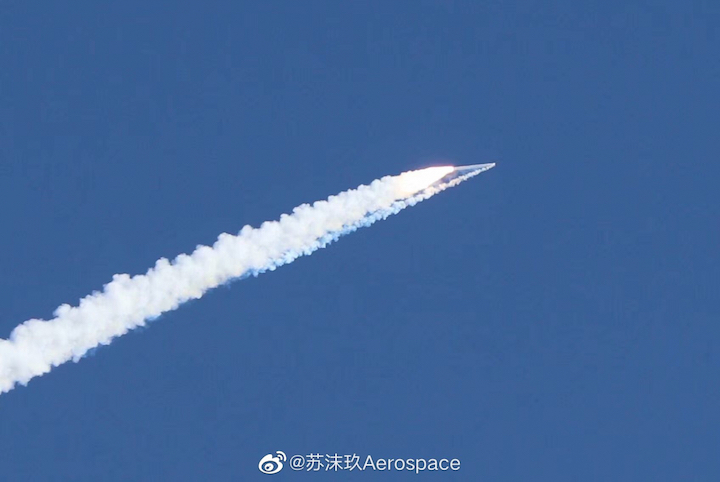3.02.2021

The Chinese private space launch company i-Space (Beijing Interstellar Glory Space Technology Ltd.) developed Hyperbola-1 (Shian Quxian-1) rocket failed in its second launch on Monday in an attempt to orbit the small Fangzhou-2 (Ark-2) satellite. The launch took place at 08:15 UTC from the Jiuquan Satellite Launch Center.
Available images from the launch show the vehicle in trouble after leaving the launch complex. Around the time of MaxQ, smoke is seeing coming from the frontal part of the launcher that disintegrated a few seconds later, with debris raining on the desert landscape around the launch site.
Possibly based on early military missile technology, the Hyperbola-1 launch vehicle is 24 meters long, 1.4 meters in diameter, and has a launch mass of 42,000 kg. It is an all-solid four-stage launch vehicle with liquid fuel guided attitude control engines.
The vehicle can launch 300 kg into a 500 km SSO. The Hyperbola-1 used on the inaugural launch on July 25, 2019, had an overall length of 20,8 meters and a launch mass of 31,000 kg.
Before its second orbital try, i-Space achieved three successful launches in less than two years. The first flight was a suborbital rocket, and the Hyperbola-1S, launched on April 5, 2018.
The second flight was a commercial sub-orbital rocket, Hyberbola-1Z, launched on September 5, 2018, from the Jiuquan Satellite Launch Center, carrying three small payloads. The third flight was Hyberbola-1 (Y1), which sent two satellites into orbit on July 25, 2019.
With this launch, the Beijing Interstellar Glory Space Technology Co., Ltd was the first Chinese private company to successfully send satellites into orbit. Simultaneously, the company had already completed the 200s-full-system test of a reusable liquid oxygen/methane rocket engine in July 2019.
The company will develop medium and heavy reusable launch vehicles in the near future, providing launching services to global satellite customers.
For this launch the outer fuselage was covered with the artistic creations of the contemporary artist Xu Bing named the rocket “Xu Bing Tianshu.” Also, inside the fairing was a metal cube representing Xu Bing’s art, “The Book of the Sky.”
On-board the second Hyperbola-1 was the small CubeSat-6U Fangzhou-2 (‘Ark-2’) satellite. The satellite’s mission was to serve as a verification platform for technologies to be used on future Fanzghou series of small and medium returnable spacecraft developed by Beijing Space Ark Space Technology Co., Ltd. (SPACE ARK).
The company was established in October 2018. An aerospace high-tech industrialization company was created in the context of the booming global commercial aerospace development and actively responding to national innovation-driven and aerospace power strategy.
Together with Aerospace Shenhe Technology (Beijing) Co., Ltd. and the commercial micro-nano satellite R&D center subordinate to the China Academy of Aerospace Systems Science and Engineering, the company gives full importance to the advantages of the market-oriented operation model and has gathered a large number of professional core technical personnel in the aerospace industry system.
Launch Site:
The Jiuquan Satellite Launch Center, in Ejin-Banner – a county in Alashan League of the Inner Mongolia Autonomous Region – was the first Chinese satellite launch center and is also known as the Shuang Cheng Tze launch center.
The site includes a Technical Centre, two Launch Complexes, Mission Command and Control Centre, Launch Control Centre, propellant fuelling systems, tracking and communication systems, gas supply systems, weather forecast systems, and logistic support systems.
Jiuquan was originally used to launch scientific and recoverable satellites into medium or low earth orbits at high inclinations. It is also the place from where all the Chinese crewed missions are launched. The LC-43 launch complex, also known as South Launch Site (SLS), is equipped with two launch pads: 91 and 94. Launch pad 91 is used for the crewed program to launch the Long March-2F launch vehicle (Shenzhou and Tiangong). Launch pad 94 is used for unmanned orbital launches by the Long March-2C, Long March-2D, and Long March-4C launch vehicles.
The LC-43 launch complex, also known as South Launch Site (SLS), is equipped with two launch pads: 91 and 94. Launch pad 91 is used for the crewed program to launch the Long March-2F launch vehicle (Shenzhou and Tiangong). Launch pad 94 is used for unmanned orbital launches by the Long March-2C, Long March-2D, and Long March-4C launch vehicles.
Other launch zones at the launch site are used for launching the Kuaizhou, Kaituo, and the Long March-11 solid propellant launch vehicles, as well as a launch area for the privately developed launchers.
The first orbital launch took place on April 24, 1970, when the Long March-1 rocket launched the first Chinese satellite, the Dongfanghong-1 (04382 1970-034A).
Quelle: AS
